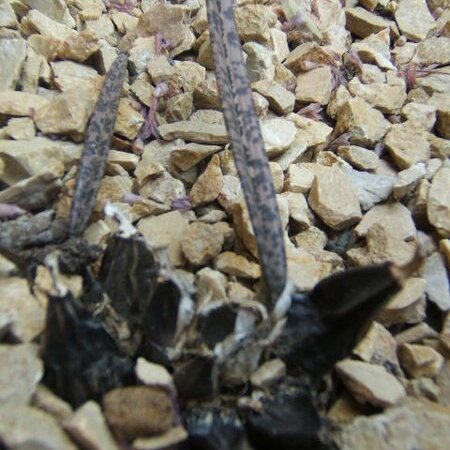Plants: pseudobulbs ovoid, 30 x 20 mm; leaves 3 per pseudobulb, sessile, linear, acute, erect, 180-220 x 12-20 mm. Inflorescences to 1 m tall, racemose, laxly many-flowered; sheaths papery, acute, 35 mm long; bracts linear-lanceolate, less than half as long as the 20 mm long pedicels. Flowers 30 mm across, dark green with purple veins, lip midlobe cream or pale green. Sepals subequal, spathulate, blades elliptic, acute, 6 x 3.5 mm, stalk 10 x 1 mm; median sepal slightly shorter than the laterals. Petals oblong, obtuse, 8 xmm. Lip crest a transverse ridge; midlobe very deeply lobulate, lobes spreading, flabellate, 8 x 6 mm, margins crenulate; side lobes porrect, rounded, 4 mm tall; spur cylindrical, rounded, curved forwards, 5 mm long. Gynostemium erect,mm tall.
Lip 12–16 mm long, 12–18 mm wide, appearing 4-lobed (3-lobed with the mid-lobe 2-lobed); each lobe of mid-lobe suborbicular or broadly oblong; side lobes erect, subquadrate; base of lip with a callus formed of 2 raised, oblong lobes which extend to the apical sinus as 2 low, minutely papillose keels, often with a third median keel; spur 3–6 mm long, stout, decurved, cylindrical but often slightly swollen in the middle, the apex blunt.
Sepals and petals dark olive-green or yellow-green, veined with purple; lip yellow, cream or pale green with purple or red nerves and a central yellow patch; crests lilac; spur orange or green.
Leaves 12–21 × 1–1.5 cm, linear to narrowly lanceolate, tapering to a petiolate base 3–10 cm long, coriaceous, grey-green with blue-grey or whitish-grey blotches.
Inflorescence simple, 22–60 cm tall, laxly 9–20-flowered, the scape with c. 12 linear bracts 1–2 cm long.
Petals 7–10 × 4–7 mm, oblong-elliptic or ovate-elliptic, apiculate, narrowed at base.
Pseudobulbs 2–4 × 1.5–2.5 cm, conical to ovoid, 5-angled, usually 2-leaved.
Column erect, 4–5 mm long with a short foot c. 2 mm long.
Sepals 12–20 × 2.5–4 mm, spathulate, apiculate.
Pedicel and ovary 12–25 mm long, slender.
Glabrous terrestrial herb 50–80 cm high.
Bracts 5–15 mm long, linear.

